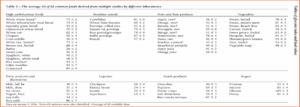Review Article | Vol. 1, Issue 1 | Archives of Endocrinology and Disorders | Open Access |
Impact of Glycemic Index-Based Nutrition Education on Blood Glucose Control Among Persons Living with Diabetes Mellitus
Rabi Ilemona Ekore1*, Hany Mohammed2, Nivin Youssef1, Emanuela Rucci3
1Family Medicine Unit, Dhaman Primary Healthcare Centre, Kuwait
2Al Salam Hospital, Al Asimah, Kuwait
3Paediatric Unit, Dhaman Primary Healthcare Centre, Kuwait
*Correspondence author: Rabi Ilemona Ekore, Family Medicine Unit, Dhaman Primary Healthcare Centre, Kuwait;
Email: [email protected]
Citation: Ekore RI, et al. Impact of Glycemic Index-Based Nutrition Education on Blood Glucose Control Among Persons Living with Diabetes Mellitus. Arch Endocrinol Disord. 2025;1(1):1-6.
Copyright© 2025 by Ekore RI, et al. All rights reserved. This is an open access article distributed under the terms of the Creative Commons Attribution License, which permits unrestricted use, distribution, and reproduction in any medium, provided the original author and source are credited.
| Received 09 April, 2025 | Accepted 23 April, 2025 | Published 30 April, 2025 |
Abstract
Blood glucose management is a critical aspect of diabetes care in which diet, and nutrition play important roles. The Glycemic Index (GI) of food measures how much, and how quickly a food can raise blood glucose levels, using it in meal planning can improve diabetes, control, and physician knowledge of GI of common foodstuff can enhance diabetes management. There is paucity of data on the state of knowledge of physicians on GI of foodstuff. This study is a narrative review of the impact of Glycaemic Index-based nutrition education on blood glucose control in patients living with diabetes mellitus. Literature search conducted to retrieve evidence from electronic databases revealed that low GI diets demonstrated significant decrease in HbA1c compared to control diets, nutrition therapy involving low GI foods significantly improved biochemical indices , while nutrition education on low GI foods improved dietary intake, knowledge, and empowerment for diabetes management in adults, improved glycemic control, was associated with fewer episodes of hyperglycemia, and enhanced quality of life among children with T1DM. A doctor’s knowledge of the glycemic indices of common foodstuff can improve a physician’s clinical practice by positively impacting blood glucose control in diabetic patients, and education on low-GI diets can lead to a decrease in HbA1c.
Keywords: Glycemic Index; Blood Glucose Levels; Blood Glucose; HbA1c; Diabetic Patients
Introduction
Blood glucose management in patients living with diabetes mellitus is a critical aspect of their care, and one approach to this is modifying the patient’s diet. As important as diet is, however, it might be inadequate as the sole means of long-term maintenance of good glycaemic control, and the subsequent prevention of complications [1,2]. Glycaemic Index (GI) is a ranking of foods based on their glycemic effect compared with a standard food, and measures the post-prandial potential of carbohydrate-containing foods to raise blood glucose levels, relative to glucose or white bread [3,4]. On a scale of 1 – 100, GI can be classified as low (<55), intermediate (55 – 70), and high (>70). It indicates how much, and how quickly a food can raise blood glucose levels, and is a tool that can be used to guide dietary choices for individuals with diabetes. The GI of foods may play a role in preventing, and treating chronic diseases by improving blood glucose control, lipid profile,, and weight control [5]. The American Diabetes Association’s Council on Nutrition has acknowledged the potential benefits of using GI in meal planning for diabetic patients, suggesting it could lead to lower glycemic responses to meals [6]. Lee asserts that using the GI in meal planning can improve diabetes control, and overall health, but it’s important to focus on the overall glycemic impact of a meal rather than the numerical values of individual foods [7].
The preceding information suggests that knowledge of glycemic indices of common foodstuff can improve physicians’ clinical practice by enhancing diabetes management. However, there is paucity of data on the state of knowledge of physicians on GI of foodstuff although related studies revealed that medical students, and intern physicians have limited knowledge about the GI of popular food products despite their interest in healthy eating, and about nutrition, and diabetes respectively [8,9].
Objective
This study is a narrative review of the impact of glycaemic index-based nutrition education on blood glucose control in patients living with diabetes mellitus, to provide a basis for a renewed call for awareness, and action on the part of physicians.
Methods
Literature search was conducted to retrieve evidence from electronic databases, including PubMed, EMBASE, Cochrane Library, Google Scholar, and CINAHL. Search terms included dietary management of diabetes, diabetes nutrition education, and glycaemic index of food.
Results, and Discussion
Various types of diets have been studied to ascertain their effectiveness in achieving glycaemic control among persons living with diabetes mellitus. Examples include low carbohydrate diet, plant-based diet, ketogenic diet, low-GI diet, mediterranean diet, and so on. Banaszak, et al., conducted a systematic review of 44 studies on the effectiveness of plant-based diets on insulin resistance, and revealed that vegetarian diets had beneficial effects via reduced insulin resistance or increased sensitivity, as well as on body weight, body fat, BMI, and lipid profile but improperly balanced plant-based diets had an attendant risk of nutritional deficiencies, especially in protein, B vitamins, iron, zinc, and omega 3 fatty acids [10]. Jardine, et al., also asserted the effectiveness of low-fat, plant-based diets in improving body weight, glycemic control, plasma lipid concentrations, and blood pressure, as well as reducing the risk of CVD, and microvascular complications in persons living with Type 2 diabetes mellitus [11]. A systematic review of 14 ketogenic diets on their effect on blood sugar control revealed a reduction of HbA1c levels in as little as three weeks, along with weight loss, and lowering of required blood glucose lowering medications. A cause-effect relationship between ketogenic diets, and HbA1c levels reduction could, however, not be proven [12]. Similarly, Kashyap et al, conducted a systematic review, and meta-analysis of sixteen (16) studies on the effectiveness of very low-calorie diets, and low-fat vegan diets on weight, and glycemic markers in type 2 diabetes mellitus, and their findings among others were that very low-calorie diets significantly improved glycaemic control, with reductions in fasting glucose, and HbA1c compared to non-dietary therapy [13].
Jing, et al., systematically reviewed 42 Randomized Controlled Trials (RCTs) which compared ten dietary approaches to managing Type 2 DM [14]. The diets compared were low-carbohydrate, moderate-carbohydrate, ketogenic, low-fat, high-protein, Mediterranean, Vegetarian/Vegan, low Glycemic Index, recommended, and control diets, and the study revealed that the ketogenic, low-carbohydrate, and low-fat diets were significantly effective in reducing HbA1c while moderate-carbohydrate, low Glycemic Index, Mediterranean, high-protein, and low-fat diets were significantly effective in reducing fasting glucose compared to a control diet. Their ranking for combined outcomes indicated the ketogenic, mediterranean, moderate- carbohydrate, and low Glycemic Index diets had promising effects for controlling HbA1c, and fasting glucose. A similar systematic review was conducted by Papamichou, et al., on Randomized Controlled Trials (RCTs) that studied the effectiveness of low carbohydrate, macrobiotic, vegan, vegetarian, Mediterranean, and Intermittent Fasting (IF) diets compared to low fat diets on diabetes control, and management [15]. Their findings from fifteen of the trials which were specifically done with low carbohydrate diets revealed that only four of the low carbohydrate diets were associated with a reduction of HbA1c levels.
Foods of the various classes may be low, intermediate or high GI irrespective of whether they are cereal, legume, fruit or vegetable. Atkinson, et al., conducted a study in which they systematically tallied GI values for over 2,480 individual food items, and the study revealed that dairy products, legumes, and fruits have low GI values, while breads, breakfast cereals, and rice have both high, and low GI versions [16]. Table 1 below 16 lists the average GI of some commonly eaten foods.

Table 1: The average GI of some common foods.
Low GI foods are recommended to improve overall glycemic control in both type 1, and type 2 diabetic patients, specifically in correcting excessive postprandial hyperglycemia, and were found to be effective at reducing glycated hemoglobin (HbA1c), fasting glucose, total cholesterol, as well as in improving nutrition, knowledge, and empowerment for diabetes management in adults, but had no effect on triglycerides or insulin requirements [17-22]. A low GI diet studied by Wolever, et al., was found to improve blood glucose, and lipid control in patients with Non-Insulin-Dependent Diabetes Mellitus (NIDDM), while Pei-Ying found that consumption of mixed food from low GI diet compositions was favorable in controlling blood sugar, and improving nutritional status in diabetic patients [23,24]. Furthermore, Thomas, and Elliott in their systematic review to assess the effects of low GI diets on glycaemic control among diabetic patients demonstrated a significant decrease in glycated Hb (HbA1c) with low-GI diet than with the control diet, indicating better improvement of glycaemic control with the low-GI diet [18]. This is supported by Livesey, et al., whose systematic review, and meta-analysis on relations between dietary glycemic properties, and health outcomes confirmed that GL or Glycaemic Load (GL) had a significantly stronger relation with glycemic control than does available carbohydrate in the context of minimal change in fat intake [25]. Even among children living with Type 1 diabetes low GI diet demonstrated improved glycemic control, and was associated with fewer episodes of hyperglycemia, and an enhanced quality of life, compared to a measured carbohydrate exchange diet [26]. In the same vein, practical application of GI in guiding diet planning for diabetic patients effectively controlled blood sugar, and nutrition therapy with low GI foods significantly improved biochemical indices such as fasting and postprandial blood glucose levels, and insulin sensitivity in type 2 diabetic patients [7,21,27,28]. Importantly, low GI dietary advice did not appear to limit food choices, making it a practical approach for managing diabetes without negatively impacting dietary quality [29].
Nutrition education intervention on GI and GL can improve dietary intake, knowledge, and empowerment for diabetes management in adults, and is important for controlling blood glucose, and lipids, as well as improving nutrition in patients with type 2 diabetes mellitus [20-22]. Glycemic Index-based nutrition education improved blood glucose control more effectively than conventional nutrition education, while combining nutrition education with Self-Monitoring of Blood Glucose (SMBG) also decreased HbA1c, and BMI indicating that patient engagement, and education are crucial for effective diabetes management [21,22,30,32]. Amano, et al., in their randomized controlled trial demonstrated that GI-Based Nutritional Education improves blood glucose control more effectively than conventional nutrition education in Japanese adults with type 2 diabetes or impaired fasting glucose, corroborating available evidence that lowering the GI of the diet contributes to improved glycemic control in diabetes [30]. Yu-Ling, observed that education on low GI foods was beneficial for type 2 diabetic patients in controlling their blood sugar levels while Lee asserts that a practical application of the GI in meal planning can improve diabetes control and other health parameters without the need for patients to calculate the GI/GL of complex meals [7,31]. Fortunately, patients are willing to learn about GI of foods, desiring more knowledge of the relationship between GI, and blood glucose level as well as specific strategies for achieving a lower GI diet, and should thus be given the opportunity to adopt this diabetes care option as early on in treatment as possible [33].
Knowledge of the GI values of developed ready-to-eat meals can guide food choices for individuals with diabetes, and obesity, as these meals have been shown to affect blood glucose, and insulin levels [34]. Physicians, and other relevant health workers need to be knowledgeable about the GI of foods if complete, accurate, and relevant information is to be provided when educating patients, and their families about the dietary aspect of diabetes care. There is paucity of information on the level of knowledge physicians on the GI of foods. However, newly graduated medical interns’ responses to questions on the nutrition, and diabetes axis of a survey showed that correct answers accounted for 55.6% of the questions, and wrong answers accounted for 44.4% [9]. In their systematic review conducted to evaluate the evidence of the effectiveness of individual consultations provided exclusively by primary care-based dietitians to support adult patients to modify dietary intake, Mitchell, et al., demonstrated that dietetic consultations for adults in primary care settings appear to be effective for improvement in diet quality, diabetes outcomes such as blood glucose, and glycated haemoglobin values, and weight loss outcomes [2]. Hence, as a matter of ensuring the provision of holistic care, as soon as diagnosis of diabetes mellitus is confirmed all components of diabetes care should be presented to, and discussed with the patient, including dietary modification, exercise, medication use, self-monitoring, and the high likelihood of eventually incorporating insulin therapy in future even if not indicated at the time of diagnosis [1]. Finally, in as much as low-GI, and other types of diets have demonstrated the ability to assist in improving glycaemic control, and weight loss, Chester, et al., asserted that patient adherence, acceptability, and long‐term manageability play essential roles in the efficacy of each diet [35].
Conclusion
Low GI diets are associated with improvements in various health markers related to diabetes management. However, it is important to consider the GI in the context of a comprehensive dietary approach that includes other nutritional indicators, and factors. The reviewed studies suggest that education, and application of low GI diets improve glycemic control via decreasing HbA1c levels, enhancing patient knowledge, and contributing to better management of diabetes.
Low GI-based nutrition education has been demonstrated to be beneficial for effective blood glucose control, hence, a doctor’s knowledge of the GI can presumably exert a positive impact on blood glucose control by helping to improve blood sugar levels, and the overall nutritional status in patients living with diabetes. This suggests that incorporating GI knowledge into dietary planning is a valuable strategy for diabetes care. It is therefore recommended that physicians should ensure adequate knowledge of the GI of common foods in order to optimize the provision of nutrition education to patients living with diabetes.
Conflict of Interest
The authors declare that they have no conflict of interest.
Consent to Participate
Not applicable.
Financial Disclosure
This research did not receive any grant from funding agencies in the public, commercial or not-for-profit sectors.
Data Availability
Not applicable.
Author’s Contribution
The authors contributed equally.
References
- Ekore RI, Ekore JO. Dietary management of diabetes: A practical approach for primary care physicians in Nigeria. 2008;16(2):13-4.
- Mitchell LJ, Ball LE, Ross LJ, Barnes KA, Williams LT. Effectiveness of dietetic consultations in primary health care: A systematic review of randomized controlled trials. J Acad Nutr Diet. 2017;117(12):1941-62.
- Augustin LS, Franceschi S, Jenkins DJ, Kendall CW, La Vecchia C. Glycemic Index in chronic disease: A review. European J Clin Nutr. 2002;56(11):1049-71.
- Eleazu CO. The concept of low Glycemic Index, and glycemic load foods as panacea for type 2 diabetes mellitus; prospects, challenges, and solutions. Afr Health Sci. 2016;16(2):468-79.
- Esfahani A, Wong JM, Mirrahimi A, Srichaikul K, Jenkins DJ, Kendall CW. The Glycemic Index: Physiological significance. J American College of Nutrition. 2009;28(sup4):439S-45S.
- Hollenbeck CB, Coulston AM, Reaven GM. Glycemic effects of carbohydrates: A different perspective. Diabetes Care. 1986;9(6):641-7.
- Lee J. Utility of the Glycemic Index in practical diabetes management. The Journal of Korean Diabetes. 2015;16:135-40.
- Czarnota J, Dobrzyński M, Skubel T, Drozd M, Dudek I, Sokół D, et al. Study on the state of knowledge of medical students about the Glycemic Index of popular food products in Poland. A survey study. Journal of Education, Health, and Sport. 2020;10(8):291-7.
- Bawazir Z, Alrasheedi A, Aljehany B. Nutritional knowledge, and attitudes among physician interns graduated from King Abdul-Aziz University, Jeddah, Saudi Arabia. Healthcare. 2022; 10(9):1788.
- Banaszak M, Górna I, Przysławski J. Non-pharmacological treatments for insulin resistance: effective intervention of plant-based diets: A critical review. Nutrients. 2022;14(7):1400.
- Jardine MA, Kahleova H, Levin SM, Ali Z, Trapp CB, Barnard ND. Perspective: Plant-based eating pattern for type 2 diabetes prevention, and treatment: efficacy, mechanisms, and practical considerations. Adv Nutr. 2021; 12(6): 2045-255.
- Tinguely, D., Gross, J., and Kosinski, C. Efficacy of ketogenic diets on type 2 diabetes: A systematic review. Curr Diab. 2021;21:31.
- Kashyap A, Mackay A, Carter B, Fyfe CL, Johnstone AM, Myint PK. Investigating the effectiveness of very low-calorie diets, and low-fat vegan diets on weight, and glycemic markers in type 2 diabetes mellitus: A systematic review, and meta-analysis. Nutrients. 2022;14(22):4870.
- Jing T, Zhang S, Bai M, Chen Z, Gao S, Li S, et al. Effect of dietary approaches on glycemic control in patients with type 2 diabetes: a systematic review with network meta-analysis of randomized trials. Nutrients. 2023;15(14):3156.
- Papamichou D, Panagiotakos DB, Itsiopoulos C. Dietary patterns, and management of type 2 diabetes: A systematic review of randomised clinical trials. Nutr Metab Cardiovasc Dis. 2019; 29(6): 531-43.
- Atkinson FS, Foster-Powell K, Brand-Miller JC. International tables of Glycemic Index, and glycemic load values: 2008. Diabetes Care. 2008;31(12):2281-3.
- Slama G, Elgrably F, Kabir M, Rizkalla S. Low Glycemic Index foods should play a role in improving overall glycemic control in type-1, and type-2 diabetic patients and, more specifically, in correcting excessive postprandial hyperglycemia. Nestle Nutrition Workshop Series. Clinical, and Performance Programme 2006;11:73-81.
- Thomas D, Elliott E. The use of low-glycaemic index diets in diabetes control. British J Nutrition. 2010;104:797-802.
- Zafar MI, Mills KE, Zheng J, Regmi A, Hu SQ, Gou L, et al. Low-Glycemic Index diets as an intervention for diabetes: A systematic review, and meta-analysis. Am J Clin Nutr. 2019;110(4):891-902.
- Miller, C., and Gutschall, M. A randomized trial about Glycemic Index, and glycemic load improves outcomes among adults with type 2 diabetes. Health Education, and Behavior. 2009;36:615-26.
- Chuan-me, W. Effect of nutrition therapy of low Glycemic Index foods on type 2 diabetic patients. West China Medical J. 2009;24(12):3137-9.
- Yan-juan Z. Application of low Glycemic Index diet in diabetes, and its effect on biochemical indicators. Chinese General Practice. 2012;
- Wolever TM, Nguyen PM, Chiasson JL, Hunt JA, Josse RG, Palmason C, et al. Determinants of diet Glycemic Index calculated retrospectively from diet records of 342 individuals with non-insulin-dependent diabetes mellitus. The Am J Clin Nutr. 1994;59(6):1265-9.
- Pei-ying W. Effects of mixed food on nutritional status, and blood sugar in type 2 diabetic patients. Modern Medicine Health. 2010.
- Livesey G, Taylor R, Hulshof T, Howlett J. Glycemic response, and health: A systematic review, and meta-analysis: relations between dietary glycemic properties, and health outcomes. The Am J Clin Nutr. 2008;87(1):258S-68S.
- Gilbertson HR, Brand-Miller JC, Thorburn AW, Evans S, Chondros P, Werther GA. The effect of flexible low Glycemic Index dietary advice versus measured carbohydrate exchange diets on glycemic control in children with type 1 diabetes. Diabetes Care. 2001;24(7):1137-43.
- Hui-yin L. Research progress of Glycemic Index, and prediction model. Practical Preventive Medicine. 2014.
- Järvi AE, Karlström BE, Granfeldt YE, Björck IE, Asp NG, Vessby BO. Improved glycemic control, and lipid profile, and normalized fibrinolytic activity on a low-Glycemic Index diet in type 2 diabetic patients. Diabetes Care. 1999;22(1):10-8.
- Gilbertson, H., Thorburn, A., Brand-Miller, J., Chondros, P., and Werther, G. Effect of low-glycemic-index dietary advice on dietary quality, and food choice in children with type 1 diabetes. The Am J Clin Nutr. 2003;77(1):83-90.
- Amano Y, Sugiyama M, Lee JS, Kawakubo K, Mori K, Tang AC, et al. Glycemic Index–based nutritional education improves blood glucose control in Japanese adults: A randomized controlled trial. Diabetes Care. 2007;30(7):1874-6.
- Yu-ling Z. Effect of nutritional education of low Glycemic Index foods on type 2 diabetic patients. Nursing Practice, and Research. 2011.
- Miyo H, Hideo S, Masao H, Nobuko M. Effect of nutrition education using Self-Monitoring of Blood Glucose (SMBG) on glycemic control in non-insulin-treated obese type 2 diabetes patients. Food, and Nutrition Sciences. 2012;2012.
- Davis MS, Miller CK. Educational needs regarding the Glycemic Index in diabetes management. Topics in Clinical Nutrition. 2006;21(1):17-25.
- On-Nom N, Chamchan R, Charoensiri R, Kongkachuichai R, Chupeerach C. The developed ready to eat meal affected to blood glucose, and insulin in healthy subjects: Glycemic Index study. Curr Res Nutrition, and Food Science J. 2022;10(1):231-9.
- Chester B, Babu JR, Greene MW, Geetha T. The effects of popular diets on type 2 diabetes management. Diabetes Metab Res Rev. 2019;35(8):e3188.
Author Info
Rabi Ilemona Ekore1*, Hany Mohammed2, Nivin Youssef1, Emanuela Rucci3
1Family Medicine Unit, Dhaman Primary Healthcare Centre, Kuwait
2Al Salam Hospital, Al Asimah, Kuwait
3Paediatric Unit, Dhaman Primary Healthcare Centre, Kuwait
*Correspondence author: Rabi Ilemona Ekore, Family Medicine Unit, Dhaman Primary Healthcare Centre, Kuwait;
Email: [email protected]
Copyright
Rabi Ilemona Ekore1*, Hany Mohammed2, Nivin Youssef1, Emanuela Rucci3
1Family Medicine Unit, Dhaman Primary Healthcare Centre, Kuwait
2Al Salam Hospital, Al Asimah, Kuwait
3Paediatric Unit, Dhaman Primary Healthcare Centre, Kuwait
*Correspondence author: Rabi Ilemona Ekore, Family Medicine Unit, Dhaman Primary Healthcare Centre, Kuwait;
Email: [email protected]
Copyright© 2025 by Ekore RI, et al. All rights reserved. This is an open access article distributed under the terms of the Creative Commons Attribution License, which permits unrestricted use, distribution, and reproduction in any medium, provided the original author and source are credited.
Citation
Citation: Ekore RI, et al. Impact of Glycemic Index-Based Nutrition Education on Blood Glucose Control Among Persons Living with Diabetes Mellitus. Arch Endocrinol Disord. 2025;1(1):1-6.



